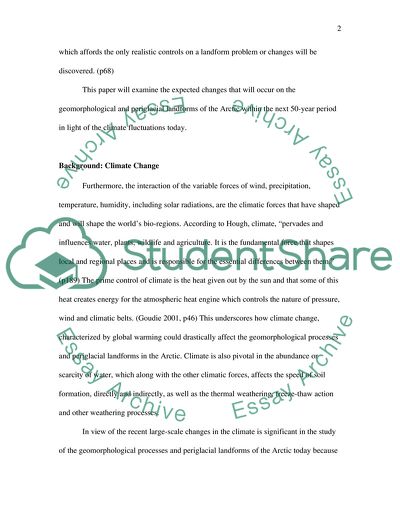Cite this document
(Arctic Climate Impact Case Study Example | Topics and Well Written Essays - 2000 words, n.d.)
Arctic Climate Impact Case Study Example | Topics and Well Written Essays - 2000 words. Retrieved from https://studentshare.org/environmental-studies/1737529-in-physical-geography-periglacial-geomorphology-how-might-the-geomorphological-processes-and-periglacial-landforms-of-the-arctic-or-alpine-zones-choose-one-change-as-a-result-of-climate-change-over-the-next-50-years
Arctic Climate Impact Case Study Example | Topics and Well Written Essays - 2000 words. Retrieved from https://studentshare.org/environmental-studies/1737529-in-physical-geography-periglacial-geomorphology-how-might-the-geomorphological-processes-and-periglacial-landforms-of-the-arctic-or-alpine-zones-choose-one-change-as-a-result-of-climate-change-over-the-next-50-years
(Arctic Climate Impact Case Study Example | Topics and Well Written Essays - 2000 Words)
Arctic Climate Impact Case Study Example | Topics and Well Written Essays - 2000 Words. https://studentshare.org/environmental-studies/1737529-in-physical-geography-periglacial-geomorphology-how-might-the-geomorphological-processes-and-periglacial-landforms-of-the-arctic-or-alpine-zones-choose-one-change-as-a-result-of-climate-change-over-the-next-50-years.
Arctic Climate Impact Case Study Example | Topics and Well Written Essays - 2000 Words. https://studentshare.org/environmental-studies/1737529-in-physical-geography-periglacial-geomorphology-how-might-the-geomorphological-processes-and-periglacial-landforms-of-the-arctic-or-alpine-zones-choose-one-change-as-a-result-of-climate-change-over-the-next-50-years.
“Arctic Climate Impact Case Study Example | Topics and Well Written Essays - 2000 Words”. https://studentshare.org/environmental-studies/1737529-in-physical-geography-periglacial-geomorphology-how-might-the-geomorphological-processes-and-periglacial-landforms-of-the-arctic-or-alpine-zones-choose-one-change-as-a-result-of-climate-change-over-the-next-50-years.


